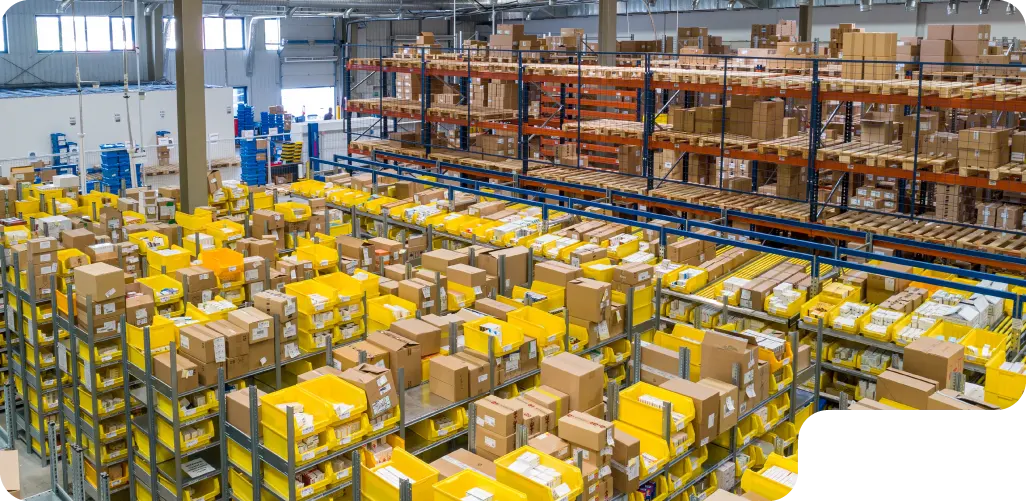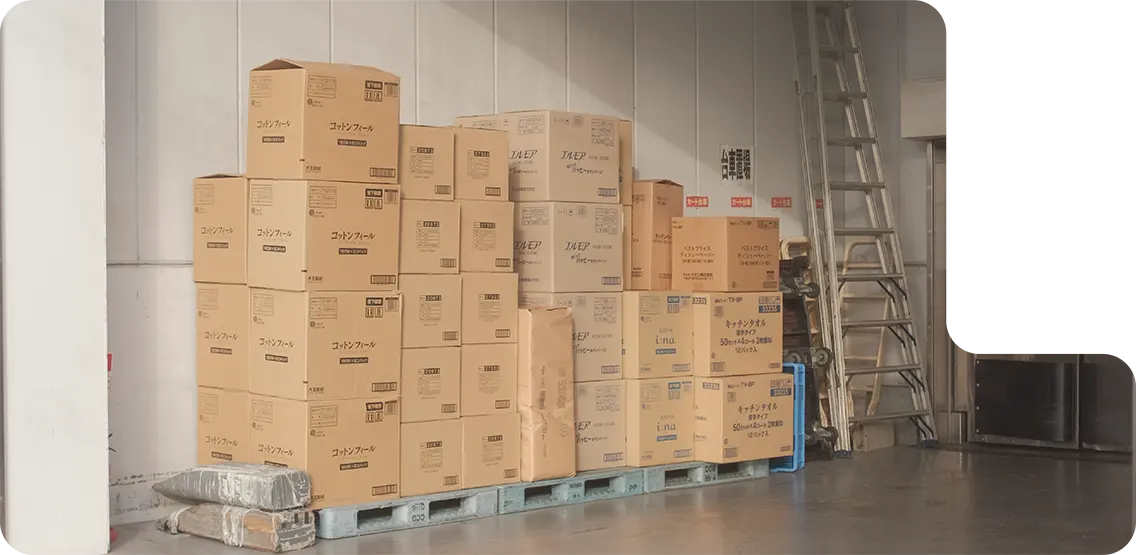Table of Contents
More Pick and Pack Content
Get the latest e-commerce industry news, best practices, and product updates!
Table of Contents
More Pick and Pack Content
Share This
Get the latest e-commerce industry news, best practices, and product updates!
Table of Contents
Share This
More Pick and Pack Content
Get the latest e-commerce industry news, best practices, and product updates!
An efficient and successful order fulfillment process comprises much more than mainstream supply chain operations. The order processing inventory involves several steps apart from neatly stacked product shelves. Fulfillment centers act as a center for command in the overall logistics operations of a company.
The basics of a typical logistics operation include picking, packing, and shipping the manufactured or finished products to their final destination. Essentially, the whole process follows just after an order is placed by a customer or a retailer for market demand. Pick and pack in logistics is nearly essential to promise a seamless supply chain operation, leading to improved customer satisfaction and increased brand recognition.
Let us know everything we need to know about the importance of the order pick and pack system and how to make it work for the company.

What is Pick and Pack?
The term pick and pack refers to the warehouse operations that involve choosing the exact type and number of items from the inventory according to the order and accurately packing them for shipping. Pick and pack eliminates the extra work and repacking, resulting in faster packing.
Generally, pick and pack is used by e-commerce retailers who deal with small-scale orders globally. This process often relies on manual intervention to select the required items and place them in stipulated packages for the final shipment to the addressed customers. Pick and pack, when practised correctly, can save a lot of time and resources, including limited freight charges and other extra expenses.

Picking and Packing Methods
When a company receives shipments, the items are counted and stored in an organized way to form a dynamic strategy for ordering fulfillment. An efficient pick and pack method reduces the chance of mistakes and order returns and increase customer satisfaction. Four distinctive order-picking techniques are widely utilized for a seamless supply chain process.
Piece picking
Piece picking is the most common method of order picking strategy. It is, in fact, the most sought strategy because it is straightforward. In this method, the workers pick orders individually, one at a time, as they are received. The orders are prepared separately by picking each item off the inventory until its completion. However, piece picking is best suited for small businesses with small order fulfillment.
Batch picking
Batch picking is an efficient strategy for warehouses with recurring traffic. This method involves picking items for orders with similar item requirements. A worker can fulfill more than one order at a time through batch picking.
Zone picking
This picking method divides the warehouses into several areas called zones. Zone picking requires the orders to be picked from assigned zones. Zone picking is a complex network comprising multiple zone requirements. In zone picking, the order boxes are passed either manually or through a conveyor belt for the final order fulfillment. Zone picking is the best-suited technique for larger fulfillment warehouses.
Wave picking
Wave picking is the combination of zone picking and batch picking method. The orders are picked in batches from different zones through this picking strategy, and the order is fulfilled only within the stipulated zones.

Pick and Pack Warehouse Setup
The effectiveness and efficiency of warehouse fulfillment operations depend on several factors including a proper warehouse structure. Warehouse layout plays a vital role in the fulfillment process. Establishing an organized and efficient pick and pack warehouse setup results in accurate processing and helps acquire accurate metrics and other KPIs required for supply chain analytics. Some efficient pick and pack warehouse layouts are :
Chaotic inventory management
In chaotic inventory management, the inventory is randomly organized for order picking accuracy. In this inventory management, no two products similar to each other are placed together. A chaotic inventory management system works best with efficient inventory management software. The inventory management software maps and stores the accurate position of all the items in the inventory. A chaotic inventory management strategy is the best way to scale down manual order picking errors.
Volume and class-based inventory management
The volume inventory storage allows a company to place the SKUs with a higher turnover rate close to the pick and pack station. Items that are sold at a slower pace are placed away. The volume inventory management system allows the picking process to be practised faster with minimum steps in order fulfillment.
The class-based inventory management strategy helps the warehouse management system to compile the finished products into shared classes based on common traits. The classification of the products is carried out based on turnover rate, size, quality and quantity, and product nature.
Mobile shelf-based order pick systems
Mobile shelf-based order pick system or MSOP includes the usage of inventory automation technology. MSOP uses automated picking technology and robots to bring the products to the packing station.
How to Improve Pick and Pack Warehouse
As discussed earlier, the warehouse layout is essential in structuring an efficient pick and pack process. Some ways to improve warehouse pick and pack management are :
- Removing excess and unwanted inventory
- Selecting the right storage units
- Use proper storage equipment
- Minimize aisle storage widths
- Fill open vertical storage space
- Store products in optimum location units
- Utilizing random inventory storage techniques
- Use proper inventory layout control
- Performing overall layout assessment

Pick and Pack Process in a Warehouse
Every step in order fulfillment is equally essential to complete the overall fulfillment process within a supply chain. The four critical steps in the pick and pack process include :
Receiving of the order – After an order is placed, the warehouse receives the generated order slip to start the pick and pack process.
Picking – After receiving the order, the warehouse operation team picks the required items on the packing slip.
Packing – After completing the picking process, the items in each order are compiled, examined, and placed into the designated package. The packing process is then completed with a printed shipping label affixed to each package.
Shipping – Constituting the last stage of the whole process, when the order is ready for shipment, it is marked shipped once the logistics department picks up the order from the warehouse.

Pick and Pack Warehouse Vs Cross Docking
While the pick and pack warehouse strategy requires the physical presence of an inventory to complete the order fulfillment process, the cross-docking system focuses on creating a just-in-time (JIT) shipping process to complete the fulfillment process. Cross-docking emphasizes distributing the products directly to the market or customers with little or no storage time. The benefits of cross-docking include
Reduced overall costs
Cross-docking warehouse operates without a requirement for long-term storage. Therefore the extra storage costs and warehouse management expenses are avoided without affecting the fulfillment process.
Eliminates excess shipping time
Shipping is a complex process including several steps like preparing the items, packaging materials, delivering items to the agency, and a long wait time. Cross-docking reduces the overall delivery time batting out the extra logistics operations.
Reduces the risk of product damage
Cross-docking eliminates the extra shipping steps and several manual intervention steps. Pertaining to its increased speed, cross-docking reduces the probability of product damage in transit
Pick and Pack Strategies Explained
Pick and pack often is the most overlooked part of the fulfillment process in a supply chain operation. Pick and pack helps a company improve and increase its warehouse operations in a strategized manner to increase the rate of order fulfillment accuracy. The essential elements of the pick and pack process are explained below:
Order Picking
Order picking refers to selecting the precise and suitable quantities of products needed for order fulfillment from warehouse storage. The pick and pack fulfillment process is generally carried out in four distinctive ways per the company’s needs. The four pick and pack fulfillment types are piece picking, batch picking, zone picking, and wave picking.
Order Packing
Order packing involves the steps to place the items into appropriate packages for shipping. Order packing constitutes warehouse operations, including setting the picked items into designated boxes or envelopes, placing labels to the specified destination, and quality checking before final shipment.

Benefits of Pick and Pack Warehousing
Pick and pack warehouse operation does provide several benefits for your business. They are :
Increased efficiency
An efficient pick and pack process helps streamline order fulfillment by eliminating unnecessary steps and manual intervention. Pick and pack escalates the process and helps in faster delivery.
Improved customer service and satisfaction
With increased accuracy in the order fulfillment process, pick and pack allows a company to improve customer service and enhance customer satisfaction.
Decreased turnaround time
Due to accurate order fulfillment and improved shipping time, well-managed and organized order fulfillment techniques lead to a shorter order turnaround rate.
Cost-effective procedure
The pick and pack process helps optimize warehouse operations to order fulfillment. Hence, it allows a business to cut off extra warehouse expenses with decreased manual error. Thus pick and pack allows the order fulfillment to go through a streamlined process with a minimum product and time wastage.

Best Practices for Order Picking
Pick and pack strategies in warehouse management can seem simple, yet certain best practices can lead to reduced errors with effective results. Some of the ways to improve the pick and pack process include
Re-scanning – Re-scanning the products for individual orders eliminates any chance of error and wastage, allowing the business to pack the required items on the order slip.
Using correct pick and pack software – Pick and pack software helps a warehouse management team calculate the accurate packing materials. It reduces human errors and eliminates package wastage.
Using in-fill instructions – Including in-fill instructions for individual orders results in an improved pick and pack method. The in-fill instructions allow the warehouse operating team to reach for and use the proper and required materials for individual orders faster.

Improving Picking Accuracy
Some ways to improve order accuracy and productivity irrespective of warehouse management operations include,
Allocating a dedicated bin location against individual SKUs
As discussed earlier, breaking the entire inventory into specific and clearly labeled sites is essential to order picking. Dedicated storage spaces make it easier for a warehouse picker to locate the required product without difficulty. Compiling multiple SKUs in the same sub-location inevitably makes it difficult for an order picker to pick the wrong orders.
Minimize dead time
Dead time is generally referred to as the walking time inside an inventory or warehouse at the time of order picking. Reduction in dead time offers enormous payoffs for the company. Using strategies to reduce the order picking slow time results in quality pick and pack operation, allowing the business to focus more time and energy on other fulfillment operations.
Arranging the inventory based on sales
According to research, businesses tend to generate 60% of their total sales profits from just 20% of their in-house product catalog. This pertains to the fact that certain products are more likely to be sold than average inventory products. Therefore, arranging the inventory according to the sales ratio is a great way to determine the priority items over others.

Pick and Pack Warehousing Costs
The essential cost components of a fulfillment process in warehouse operations include warehouse space, labor, packing, and shipping. The cost included on each item includes
- Storage fees
- Setup fees
- Pick and pack fees
- Receiving fees
- Kitting fees
- Account management fees
- Shipping
- Product return fees

How to Manage Pick and Pack Costs?
Fulfillment warehouses with pick and pack service allow a company to streamline the process strategically to complete the fulfillment process. The basic components of the pick and pack process can be controlled with certain factors, which include
Leveraging automation to improve pick and pack efficiency
Automation is the easiest and most convenient way of improving pick and pack accuracy with reduced labor costs. Warehouse automation often comes on many levels, including a fully automated inventory system. Businesses can benefit from affordable automation techniques to streamline pick and pack operations on a high volume. Leveraging automation results in increased productivity and shorter returns on investment.
Using a full-featured warehouse management system (WMS)
Modern WMS is a basic requirement for high-end businesses. A full-featured warehouse management system is crucial for streamlining the pick and pack process for increased productivity and reduced labor costs. An efficient warehouse management system helps combine multiple orders, allowing order pickers to work on a larger order scale.
Using scanning technology
To record real-time activities and eliminate human intervention.
Using real-time data analytics
Real-time data recording eliminates human errors and can also be easily shared with other systems with absolute clarity.

Measuring order Picking
The main warehouse picking KPIs include
Rate of return – Rate of return refers to the frequency of items being returned after successful order fulfillment.
Rate of Return = No. of units returned / No. Of units sold.
Picking accuracy – Picking accuracy refers to the number of orders picked accurately in a respective accounting period.
Picking Accuracy = {( Total number of orders – Incorrect item returns) / Total number of orders } x 100
Average order processing time – Average order processing time indicates the frequency of the warehouse picking operations. Tracking average order processing time provides critical insight into the average order processing time in the warehouse.

3PL Pick and Pack
In any kind of supply chain, pick and pack is the heart of the system. The receiving, storing, and shipping of goods is crucial to any company dependent on the logistics business for working. These companies are highly reliant on the Warehouse Management System of the 3PL.
So during their partnership with the 3PL for pick and pack services, the 3PL works extensively to efficiently sort, pick, pack and deliver the goods to the client. As the WMS of the 3PL receives the order, it’s coded to detect the most efficient way of carrying out the task and notifies the warehouse associates to pick up the products in a directed manner to reduce walking distance and overlap, thereby reducing labor costs.
After the picking of the listed products, they are sent to be packed in appropriately labeled boxes with other associated materials such as dunnage and promotional materials. They are sent for quality checking to ensure that the packed items are the ones ordered and they’re in deliverable condition before being shipped. This completes the chain of pick and pack before shipment with a 3PL company.

Pick and Pack Logistics
For any company, especially e-commerce companies, pick and pack logistics is an integral part of the system. Pick and pack are the first two links of any company’s supply chain. ‘Pick’ is where the listed products are picked from the shelves and the stock and sorted for further processing until transit.
It is the most fundamental part of a WMS, and one of the most important steps, since the primary objective is to deliver the exact desired product to the customer and evasion of that can cause irreparable consequences and affect the relationship with the customer.
After picking the product, it is sent for appropriate and proper packing with specific informative labels against the suitable products with other associated materials like dunnage and promotional materials. Proper packing is essential to ensure that the product is not damaged in transit and is delivered to the customer in prime condition.
A sound pick and pack system are essential in every company aspect. In e-commerce, customer satisfaction is an important factor. A proper inventory is required to ensure efficient product delivery to carry out a smooth order fulfillment process. Sorting the products by requirement and ensuring adequate delivery deepens the roots of customer relations and lays the foundation for the long-standing goodwill and reputation of the company. An efficient order fulfillment process goes a long way in a company’s growth.

Pick and Pack Distribution
As a supply chain demands, there are different links between the steps of a transaction between the customer and the company. Pick and pack mostly appear in two of those steps. After being shipped to a delivery warehouse, the shipped products are listed on a new inventory of products that have arrived and need to be delivered.
These products are picked from the new stock that has arrived and is packed into the final delivery packages to be sent out to delivery executives in the respective regions. Distribution is the last and most crucial part of an order fulfillment system. Total awareness of warehouse holdings, necessary picking and packing, and delivery to appropriate regions are essential for completing the process.

Automated Pick and Pack Systems
Pick and pack automation allows a company to create an effective, efficient, and accurate pick, pack, and shipping system. Automated management systems can generate accurate batch orders, barcodes, and RFID tags and perform strategic inventory management tasks. Some efficient ways to scale up the pick and pack system include
Pick-to-light design
This method uses a scanner and light set-up. This method allows the order picker to scan the designated barcode or RFID tags on the product and enable the product to reach the appropriate zone within the warehouse through the LED light direction. The LED lights can be integrated into different parts of the inventory operating system and other equipment used for pick and pack operation. However, this automated inventory management system can get overwhelming in the case of high-volume orders.
Voice picking method
The voice picking system allows the warehouse management team to operate through manual instructions. Warehouse pickers use a headset to receive information and instructions about the picking process and verbally relay the confirmation via the attached mouthpiece. The voice picking method eliminates heavy paperwork and allows the warehouse to operate comprehensively.
Mobile scanner picking
Mobile scanner picking allows a warehouse to use unique barcodes and perform pick and pack operations using a quality portable scanner. This method helps the pickers to achieve an optimized process with accurate picking accuracy. Mobile scanner picking optimizes the picking route for quick order picking, saves time, and reduces wastage.
Conclusion
To conclude all that has been said above, pick and pack is necessary for every business with order fulfillment criteria. E-commerce takes the lead in the list. A good pick and pack system ensure more efficient in-order delivery within minimum time, and the process becomes almost seamless with a proper inventory.
A good warehouse management system ensures that pick and pack among all sectors are carried out with more finesse and within a minimum deadline. This provides less hassle for the warehouse associates and more customer satisfaction, thus making it an advantage for both sides of the equation.
An efficient system lessens the gap between the above factors, and businesses benefit from other associated advantages. Thus, proper pick and pack goes a long way in bringing any company to a standing success.
Sign up today and leave the logistics to us
Sign up and we will get back to you within 24 hours to discuss what services would be best for your business needs. Or speak with us now and tell us what you need.
FAQs
The pick and pack process is the procedure of picking up required products from inventory and packing them for completing the order fulfillment.
The steps in the pick and pack process constitute of
- Order Intake
- Picking
- Packing
- Shipping
The pick and pack fee includes part of warehouse expenses dealing with the picking, packing, and shipping process in order fulfillment.
Pick and pack warehousing can be designed per the requirement of individual business needs. Some efficient ways to organize pick and pack warehouse for maximum productivity include,
- Designing inventory so that the items with a higher turnover rate are placed next to the packing stations.
- Group placing of similar items for easy identification
- Arranging the inventory according to the selling rate.
Some simple yet effective ways to improve the pick and pack process include,
- Structuring the warehouse for optimal efficiency
Implementing organized warehouse - Scanning and re-scanning of orders
- Using a pick and pack automation system
- Optimize storage